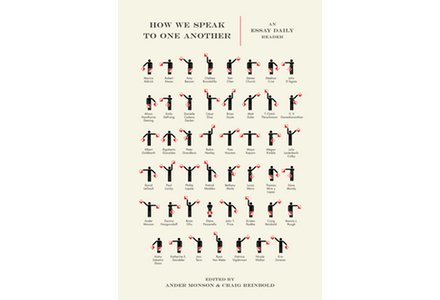A Look at Indie Authors and Their Publishers
By Lanie Tankard, Indie Book Reviews Editor

Book: How We Speak to One Another: An Essay Daily Reader
Minneapolis, MN: Coffee House Press, March 14, 2017 (328 pp; $20.00 paperback, $19.99 eBook), ISBN 9781566894579
Editors: Ander Monson and Craig Reinbold
Ander Monson wears many hats: teacher, author, and editor. He’s associate professor of English at the University of Arizona in Tucson and director of the Creative Writing Program there. And he just won a Guggenheim Fellowship.
His own writing includes fiction, poetry, and essays: The Available World, Letter to a Future Lover, Neck Deep and Other Predicaments, Other Electricities, Vacationland, and Vanishing Point. Monson is editor of the literary journal DIAGRAM and head of the affiliated New Michigan Press, which has been publishing broadsides and chapbooks since 1999. DIAGRAM and New Michigan Press run an annual contest for a chapbook of poetry, fiction, creative nonfiction, or hybrid-genre work. This year’s deadline is nearing: April 28. Monson is also founder of the Essay Daily website, a conversational space about the essay. “We mostly publish critical/creative engagements with essays (text and visual), Q&As, and reviews of essays, books, collections, or journals.”
Craig Reinbold is former Essay Daily managing editor and continues to contribute regularly. He has also been assistant editor at Terrain.org: A Journal of the Built + Natural Environments. His writing has appeared in a number of literary journals. He currently works in the emergency department of a hospital in the Milwaukee area, where he is studying to become a nurse.
Publisher: Coffee House Press
Allan Kornblum founded Coffee House Press in 1984 and served as editor and publisher for twenty-seven years. A poet, he published in a variety of small magazines during the seventies and eighties, when he was also editor, designer, printer, and publisher at Toothpaste Press. Kornblum, who died in 2014, received a 1997 American Book Award recognizing his work at both presses.
Current Coffee House publisher Chris Fischbach has been with the press for over twenty years, beginning as a letterpress intern and becoming head in 2011. He discussed his publishing philosophy in a 2014 VQR article.
Coffee House publishes “literary novels, full-length short story collections, poetry, creative nonfiction, book-length essays and essay collections, and the occasional memoir.” Submissions, currently closed, open again September 1 and do not require an agent.

Review:
“Without language thought is a vague, uncharted nebula.”
—Ferdinand de Saussure
Course in General Linguistics (p. 112)
In this collection of essays, forty-seven writers speak to other essayists (some living, some not) in conversations employing both signs and symbols. One essay appears as a black-and-white graphic comic, while another is a series of paintings—some in color. Occasionally we encounter photos among the words. One page is totally black. From time to time, an essayist reaches out to draw the reader into the chat as well.
Editor Ander Monson notes some essays have already been published elsewhere, while others appear here for the first time. He calls Essay Daily “a place to aggregate our thinking,” and defines essay as “thinking in action.”
Topics run the gamut: language identity, turtles, subway reading, old age, trout, queer trans bodies, drowning, smart phones, baseball, trail rides, failure, professional wrestling, wrens, fool’s gold. Techniques span memoir, the long lyric essay, metaphor, elision, maps, photography, memento mori, email, simile, trauma narrative, syntax, endings. Length ranges from one page to fourteen.
The essayists themselves are an array of professors, editors, poets, writers, workshop directors, investigative journalists, playwrights, translators, radio scriptwriters, and horse wranglers from around the globe: Arizona, Prague, Utah, Alaska, Singapore, Massachusetts, New York, Melbourne, Austin, Memphis, Wyoming, Iowa, Oregon, Chicago, Alabama, Minnesota, Omaha, Wichita, Ohio, San Francisco, Colorado, Philadelphia, and South Carolina. They have names like Marcia Aldrich, Robert Atwan, Rigoberto González, Phillip Lopate, Pam Houston, Patrick Madden, Bonnie J. Rough, John D’Agata, César Díaz.
The essayists dialogue with a wide variety of folks who also essay: Joan Didion, H. L. Mencken, James Agee, Ilan Stavans, Rebecca Solnit, Julian Barnes, Sarah Bakewell, Tom Junod, Claudia Rankine, Ansel Adams, Leslie Jamison, Michel de Montaigne, Donald Hall, Wendell Berry, Alison Bechdel, Jim Bouton, Cynthia Ozick, David Shoemaker, Anne Carson, Max Beerbohm, E. B. White, Louis C.K., Charles Lamb, Roland Barthes, Virginia Woolf, Percy Bysshe Shelley, Norman Mailer, Robert Frost, Michel Foucault, Gerard Manley Hopkins, Walt Whitman, Shirley Jackson, Ann Beattie, Robert Louis Stevenson.
Elegant turns of phrase abound, more frequently in some essays than in others.
Semaphore flaggers line up on the cover, each waving a letter of the alphabet, yet the translated message is a jumble of letters, with the final icon signaling “Error.” Inside, though, a six-semaphore image decodes easily into “ESSAYS.” Semaphores, designed in the late eighteenth century and used by Napoleon’s army, segue into semiotics—the study of signs and symbols and their use or interpretation. That, of course, is precisely what’s happening in this volume. Essayists parse how we communicate: nonverbal versus verbal, voiceless versus voiced, or signed versus written. Even the cover’s four-flag “Error” flourish highlights Jacques Lacan’s idea that errors can suddenly transform into truths and that truth arises from misunderstanding.
Wallace Stevens looked at a blackbird thirteen ways through poetry. These writers look at the essay forty-seven ways through both words and images, following thoughts wherever they may lead. And there, Monson notes, “sometimes something interesting happens.” In How We Speak to One Another, many interesting thoughts definitely do happen.
Copyright 2017 Woven Tale Press LLC. All Rights Reserved.

